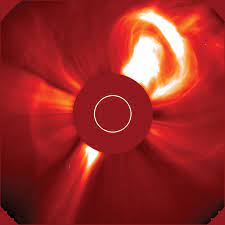Coronal Mass Ejections:

Indian Scientists, along with international collaborators, have measured the magnetic field of an eruption from the Sun’s atmosphere (solar corona), offering a rare peek to the interior of the Sun.
- Coronal Mass Ejection (CME) is one of the biggest eruptions from the Sun’s surface that can contain a billion tons of matter accelerated to several million miles per hour into space.
- Scientists from the Indian Institute of Astrophysics (IIA) studied the weak thermal radio emission associated with the erupted plasma for the first time, measuring the magnetic field and other physical conditions of the eruption.
- IIA is an autonomous institute of the Department of Science & Technology (DST), at Gauribidanur, Karnataka.
- The team studied the plasma from the Coronal Mass Ejection (CME) that happened on 1st May, 2016.
- Plasma is also known as the fourth state of matter. At high temperatures, electrons are ripped from atom’s nuclei and become a plasma or an ionised state of matter.
- The emissions were detected with the help of radio telescopes of the IIA, along with some space-based telescopes that observed the Sun in extreme ultraviolet and white light.
- They were also able to measure the polarisation of this emission, which is indicative of the direction in which the electric and magnetic components of the waves oscillate.
About the Coronal Mass Ejections:
- The Sun is an extremely active object, spewing out vast quantities of gas and plasma in many violent events.
- A class of such eruptions are Coronal Mass Ejections (CMEs).
- CMEs are the most powerful explosions happening in the solar system.
- The underlying cause of CMEs is not well understood. Astronomers agree, however, that the sun’s magnetic field plays a major role.
- Though CMEs can occur anywhere on the Sun, it is primarily those which originate from regions near the centre of the visible solar surface (called the photosphere) that are important for study, since they may propagate directly towards the Earth.
- This field of research helps to understand Space Weather.
- When a really strong CME blows past the Earth, it can damage the electronics in satellites and disrupt radio communication networks on Earth.
- When the plasma cloud hits our planet, a geomagnetic storm follows.
- A geomagnetic storm is a major disturbance of Earth’s magnetosphere (space controlled by earth’s magnetic field) that occurs when there is a very efficient exchange of energy from the solar wind into the space environment surrounding Earth.
- They can trigger intense light in the sky on Earth, called auroras.
- Some of the energy and small particles travel down the magnetic field lines at the north and south poles into Earth’s atmosphere.
- There, the particles interact with gases in the atmosphere resulting in beautiful displays of light in the sky.
- The aurora in Earth’s northern atmosphere is called an aurora borealis or northern lights. It’s southern counterpart is called an aurora australis or the southern lights.




